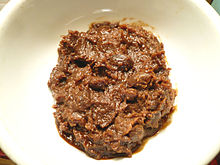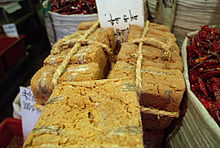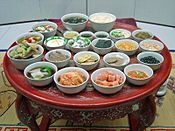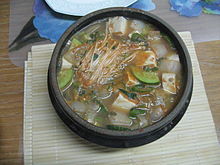- Doenjang
-
Doenjang 
Doenjang containing whole soybeansKorean name Hangul 된장 Hanja 된醬 Revised Romanization doenjang McCune–Reischauer toenjang Doenjang (Korean pronunciation: [tøndʑaŋ] or [twendʑaŋ]) (or doenzang or bean paste, HS code: 2103.90.1010) is a traditional Korean fermented soybean paste. Its name literally means "thick paste" in Korean.
Contents
Production
 Meju, soybean malt
Meju, soybean malt
To produce doenjang, dried soybeans are boiled and stone-ground into coarse bits. This paste is then formed into blocks, which are called meju (메주). The blocks are then exposed to sunlight or warmth. When so exposed, dried rice plants are attached to the surface of the soybean blocks. Dried rice plants are readily available in Korea and are a rich source of bacteria (Bacillus subtilis). The fermentation process begins at this stage. The Bacillus subtilis bacteria reproduce, consuming soybean protein and water in the meju. The unique smell of the meju is mainly the ammonia produced by the bacteria. One to three months later, depending on the block size, the meju are put into large, opaque pottery jars with brine and left to further ferment, during which time various beneficial bacteria transform the mixture into a further vitamin-enriched substance (similar to the way milk ferments to become yogurt). Liquids and solids are separated after the fermentation process, and the liquid becomes Korean soy sauce (Joseon ganjang; 조선간장). The solid, which is doenjang, is very salty and quite thick, often containing (unlike most miso) some whole, uncrushed soybeans.
While traditional homemade doenjang is made with soybeans and brine only, many factory-made variants of doenjang contain a fair amount of wheat flour just like most factory-made soy sauce does. Some current makers also add fermented, dried, and ground anchovies to accentuate the doenjang's savory flavor.
Use
A bowl of homemade doenjang jjigae
Doenjang can be eaten as a condiment in raw-paste form with vegetables, as flavored seasoning or even as a dipping condiment. However, it is more commonly mixed with garlic, sesame oil, and sometimes gochujang to produce ssamjang, which is then traditionally eaten with or without rice wrapped in leaf vegetables such as red leaf lettuce. This dish is called ssambap. This combination of leaf vegetable and doenjang (or ssamjang) often complements popular Korean meat dishes, for example samgyeopsal, bulgogi, and bossam.
It can also be used as a component of soup broth, for example in a popular stew (jjigae) called doenjang jjigae which usually includes tofu, various vegetables such as chile peppers, zucchini and scallion, and (optionally) mushrooms, red meat, or scallops.
Nutrition and health
Doenjang is rich in flavonoids and beneficial vitamins, minerals, and plant hormones (phytoestrogens) which are sometimes claimed to possess anticarcinogenic properties.[1] In Korean traditional meals, the menu has concentrated on vegetables and rice, but doenjang, which is made of soybeans, has a great deal of lysine, an essential amino acid that rice lacks. Linoleic acid (53% of the fatty acids) and linolenic acid (8% of the fatty acids) have an important role in normal growth of blood vessels and prevention of blood vessel-related illness. Unlike miso, which is usually not boiled, doenjang's efficacy still exists after boiling, in dishes such as doenjang jjigae.[2]
Knowledge and use of doenjang outside Korea
Doenjang is considered one of the essential sauces of authentic Korean cuisine. However, the condiment has historically been unknown outside of Korea, although recent international articles have resulted in an increase in its popularity. A 2007 Chinese article on the "Sauces of Korea" listed doenjang and gochujang as essential flavorings, and explored the origins of the condiments, particularly focusing on Sunchang County, where most Korean soy sauce is produced. The article pointed out that doenjang does not contain any artificial additives and in fact has healthy amounts of essential vitamins, such as vitamin C and vitamin B12. The health benefits of doenjang are rumored to extend longevity, and this is illustrated by the fact that out of the 32,000 people in Sunchung county, eight are over 100 years old and many are over 90. The article was influential throughout China, resulting in many Chinese restaurants adding doenjang stew, modified slightly to Chinese tastes, to their menus shortly after publication. South Korea's JoongAng Ilbo covered this story in China on December 13, 2007.[3]
Dajiang, a type of fermented soybean paste popular in northeast China, bears a great similarity in texture and taste to Korean doenjang. The tradition of eating dajiang is said to have been started by the Manchu people, who originally occupied China's northeastern provinces. Northeastern Chinese people enjoy eating raw vegetables in the summer, and dajiang is used like a salad dressing to add flavor.
See also
References
- ^ Prof. Kun-Young Park, Pusan National University (2005-10-26). "Korean food for defeating cancer" (in Korean). Hankook Ilbo. http://news.hankooki.com/lpage/society/200510/h2005102611373121950.htm. Retrieved 2007-11-26.
- ^ Prof. Suk Ja, Yoon Baewha Women's College (2004-04-16). "Efficacy and Nutrition of Doenjang" (in Korean). Public website. http://yijo.com/mart6/bbs.php?table=infor_01&query=print&uid=5. Retrieved 2008-01-21.
- ^ JOINS | 아시아 첫 인터넷 신문
External links
- Different ways of consuming Doenjang (video)
- Photo of South Korea-produced doenjang
- The history of doenjang
- Prof. Kun-Young Park, Pusan National University. "Longer aging time increases the anticancer and antimetastatic properties of doenjang" (in Korean). ASA-IM Korea. Archived from the original on 2007-12-05. http://web.archive.org/web/20071205081633/http://www.asa-im.or.kr/board/health_content.asp?cate=free&idx=531&page=3&search=&searchstring=&idx_image=0. Retrieved 2007-11-26.
- "Regional doenjang" (in Korean). The Rural Development Administration of South Korea. http://www2.rda.go.kr/tpd/life/html/dietary/sauce/sauce04.htm. Retrieved 2007-11-26.[dead link]
Soy General - Soy allergy
- Soy candle
- Soy ink
- Soy molasses
- Soy paint
- Soy protein
- Soybean
- Soybean diseases
- Soybean meal
- Soybean oil

Soy based dishes Milk substitute Meat analogues Sauces and condiments - Dajiang
- Doenjang
- Doubanjiang
- Douchi
- Kinema
- Miso
- Nattō
- Soy sauce
- Teriyaki
- Tauco
- Tian mian jiang
- Tương
- Yellow soybean paste
Various other foods Companies 
This article is part of a series on Korean cuisine
한국 요리AncillariesBeveragesOtherKimchi Field Museum • Kimchi refrigerator • List of Korean dishes • List of Korean beverages • Korean royal court cuisine Korea portalCategories:
Korea portalCategories:- Fermented foods
- Korean condiments
- Soy products
- Umami enhancers
Wikimedia Foundation. 2010.

